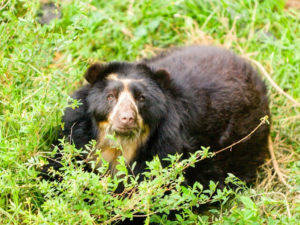
On February 21st, we celebrated World Bear Protection Day by gathering the latest updates on Andean Bears as a continued joint effort with our Peruvian sister organization Conservacion Amazonica – ACCA to protect this emblematic species.
Throughout the Kosñipata Valley, in the buffer zone of the Manu National Park near Cuzco, Peru, a team of Peruvian scientists are continuing to lead the Andean bear conservation program in collaboration with researchers, volunteers, authorities, and local communities to conduct studies on the distribution and behavior of mammals in the area help us better understand wildlife responses to environmental change and the functional diversity of ecosystems. Andean bears are vital contributors to reforestation and regulation of their environment, which is why this work done in the Kosñipata Valley not only aims to protect this culturally significant species but also to contribute to the advancement of scientific knowledge and environmental awareness.
To better understand habitat use and bear movements, scientists use GPS collars to track these bears and collect data on their movement patterns. Via telemetry, these collars have tracked the bears’ range of roughly 100 kilometers squared (about 62 miles squared), and have found that younger bears can often move even further distances. Their presence was particularly frequent among the Q’eros Nation’s region of the Peruvian Andes and has even raised some concern as they were tracked near prevalent mining zones.
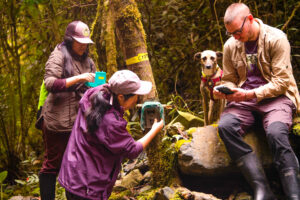 In addition to GPS tracking technologies, camera traps placed throughout the region capture images of the bears in their natural environment, providing vital information about their behavior and distribution. Through these monitoring efforts, our grounds team has recorded 43 medium to large-sized bears in more than 70,000 camera trap images throughout the studied area. As scientists continue their analysis of the Andean bear population, the exact total number of bears in the area is still unknown. The population and well-being status of these bears are still under analysis by scientists in the region. While they seem to maintain a stable population among these areas of Peru, they still face several conflicts, such as the burning of vegetation, mining in certain areas, and difficulties for non-governmental organizations to carry out conservation work in their region.
In addition to GPS tracking technologies, camera traps placed throughout the region capture images of the bears in their natural environment, providing vital information about their behavior and distribution. Through these monitoring efforts, our grounds team has recorded 43 medium to large-sized bears in more than 70,000 camera trap images throughout the studied area. As scientists continue their analysis of the Andean bear population, the exact total number of bears in the area is still unknown. The population and well-being status of these bears are still under analysis by scientists in the region. While they seem to maintain a stable population among these areas of Peru, they still face several conflicts, such as the burning of vegetation, mining in certain areas, and difficulties for non-governmental organizations to carry out conservation work in their region.
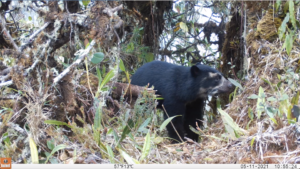 With the collection of this data, scientists can better understand these bears’ needs, habits, and impacts on the environment to fully understand their role in conservation, and allow organizations to prioritize the protection and restoration of their habitat accordingly. As an extension of this collaborative research, environmental education programs, and implementing sustainable conservation practices further prioritize this work to reduce human-bear conflicts and foster peaceful coexistence. These efforts are made possible thanks to the dedicated team of scientists from Conservación Amazónica – ACCA and the support of allied organizations such as Standler Family Charitable Foundation, ICFC, Catto Shaw Foundation, National Geographic Society, IBA, Acción Andina, Osa Conservation and Ideal Wild.
With the collection of this data, scientists can better understand these bears’ needs, habits, and impacts on the environment to fully understand their role in conservation, and allow organizations to prioritize the protection and restoration of their habitat accordingly. As an extension of this collaborative research, environmental education programs, and implementing sustainable conservation practices further prioritize this work to reduce human-bear conflicts and foster peaceful coexistence. These efforts are made possible thanks to the dedicated team of scientists from Conservación Amazónica – ACCA and the support of allied organizations such as Standler Family Charitable Foundation, ICFC, Catto Shaw Foundation, National Geographic Society, IBA, Acción Andina, Osa Conservation and Ideal Wild.

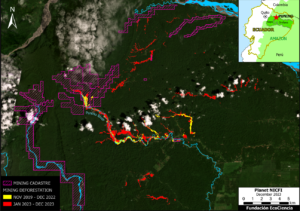 In a series of previous reports such as
In a series of previous reports such as 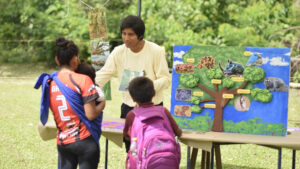 To help secure the longevity of the Amazon, part of our mission is to inspire the next generation of conservationists to take part in protecting the forests. The Amazon is home to not only an incredible array of flora and fauna but to local families and community members who also depend on its resources for their livelihood. Thus, the coexistence of people and nature is vital to keeping forests standing.
To help secure the longevity of the Amazon, part of our mission is to inspire the next generation of conservationists to take part in protecting the forests. The Amazon is home to not only an incredible array of flora and fauna but to local families and community members who also depend on its resources for their livelihood. Thus, the coexistence of people and nature is vital to keeping forests standing. 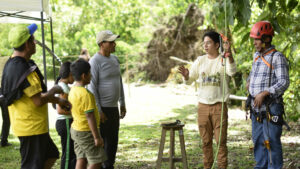 Visitors were given the opportunity to immerse themselves in the fascinating world of various animal groups by visiting detailed exhibitions on Amazonian mammals, insects, reptiles, and amphibians. Each of these exhibitions highlighted unique organism traits and key methods researchers use to study their presence in the region to better understand their impacts on the surrounding ecosystem. Additionally, the fair also offered a practical explanation of canopy climbing, a safe and sustainable method for climbing trees to help researchers study life in the treetops, an activity vital for scientific research and conservation. Visitors were amazed by the intricate details and functions of each organism and were able to explore the evolution and phylogenetic relationships between different groups of living beings, which allowed them to learn about the adaptations developed by various species to survive in their environment.
Visitors were given the opportunity to immerse themselves in the fascinating world of various animal groups by visiting detailed exhibitions on Amazonian mammals, insects, reptiles, and amphibians. Each of these exhibitions highlighted unique organism traits and key methods researchers use to study their presence in the region to better understand their impacts on the surrounding ecosystem. Additionally, the fair also offered a practical explanation of canopy climbing, a safe and sustainable method for climbing trees to help researchers study life in the treetops, an activity vital for scientific research and conservation. Visitors were amazed by the intricate details and functions of each organism and were able to explore the evolution and phylogenetic relationships between different groups of living beings, which allowed them to learn about the adaptations developed by various species to survive in their environment. 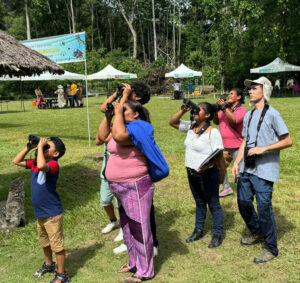 Educating others on the importance of interspecies relationships is essential for addressing crucial topics like climate change and its impact on the landscape and wildlife. Thanks to the coordination by the Manu Biological Station team, visitors were able to better understand the challenges faced by the Amazon and the importance of conserving this vital ecosystem for global balance.
Educating others on the importance of interspecies relationships is essential for addressing crucial topics like climate change and its impact on the landscape and wildlife. Thanks to the coordination by the Manu Biological Station team, visitors were able to better understand the challenges faced by the Amazon and the importance of conserving this vital ecosystem for global balance.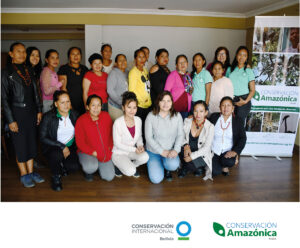
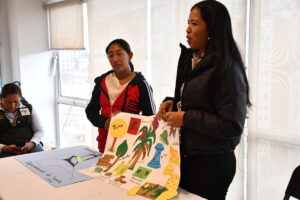 However, for women to have this leadership role, they need economic independence to support themselves and their families. For this reason, this event also had an entrepreneurship focus to strengthen their knowledge on how to establish a business and create a network to support the enrichment and experiences they share mutually. The chiquitano women from Palmarito de la Frontera Women’s Association Searching for New Horizons shared their experience with their venture with Amazonian Cusi oil, how they work among all the women, the different roles they have agreed upon, and the potential and growth that they had due to the support of organizations. The participants also received guidance from a specialist who trains and strengthens the skills of artisans and indigenous peoples by understanding cultural research, and product development, and creating a dynamic methodology adapted to their functionality.
However, for women to have this leadership role, they need economic independence to support themselves and their families. For this reason, this event also had an entrepreneurship focus to strengthen their knowledge on how to establish a business and create a network to support the enrichment and experiences they share mutually. The chiquitano women from Palmarito de la Frontera Women’s Association Searching for New Horizons shared their experience with their venture with Amazonian Cusi oil, how they work among all the women, the different roles they have agreed upon, and the potential and growth that they had due to the support of organizations. The participants also received guidance from a specialist who trains and strengthens the skills of artisans and indigenous peoples by understanding cultural research, and product development, and creating a dynamic methodology adapted to their functionality.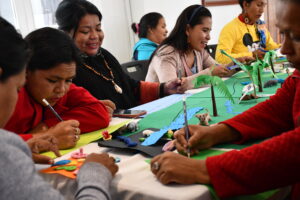 Aside from environmental threats, many of the women also reflected on their community norms that continue to make women’s rights invisible, as well as an analysis of the historical role of indigenous women participating in the fight for land, territory, natural resources, and for the self-determination of their people. While the women of Tacana II recognized that they had support from the men of their communities to exercise leadership as women, other participants shared that it continues to be a challenge to demonstrate the importance of women exercising these leadership roles and representing the voices of other women.
Aside from environmental threats, many of the women also reflected on their community norms that continue to make women’s rights invisible, as well as an analysis of the historical role of indigenous women participating in the fight for land, territory, natural resources, and for the self-determination of their people. While the women of Tacana II recognized that they had support from the men of their communities to exercise leadership as women, other participants shared that it continues to be a challenge to demonstrate the importance of women exercising these leadership roles and representing the voices of other women.